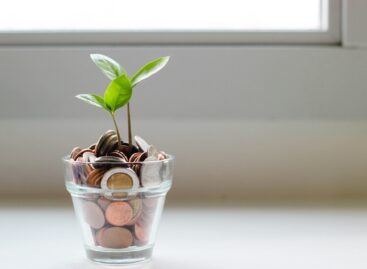(HU) Fidelity: A koronavírus hatása szélesebb körben és hosszabban érzékelhető, de a távolban látszanak a talpra állás jelei
It’s been a bout of market volatility that will likely be seared into our memories for a long time. News that the coronavirus had spread beyond China caused a rapid repricing of the consensus view that an earnings recovery was right around the corner in 2020, and that the stock market’s torrid valuation-driven advance in 2019 was justified.

3d render impression of floating coronavirus cells. Coronaviruses cause respiratory tract infections in humans and are connected with common colds, pneumonia and severe acute respiratory syndrome (SARS).
That consensus quickly crumbled as it became clear that there could be a temporary but nevertheless significant shock to both the demand and the supply side of the global economy. And even the Fed’s “emergency” half point rate cut did not halt the market slide.
As fewer people travel and go on cruises and possibly are forced to work from home, demand could come down. As countries take turns going into various forms of lockdown, supply chains could be affected as well. It’s a double shock to the system. With valuations reaching a lofty 19.1 times the forward (next 12 months) price/earnings multiple at the recent high, any derailment of the bullish narrative was poised to trigger a reset of sorts—and that’s what just happened.
The timing could not have been worse for a market that was priced for perfection.
Corrections in perspective
After a swift 15% decline in the S&P 500 (measured from intra-day peak to intra-day low), let’s assess the damage and see what we can learn from history.
While the drop has been one for the record books in terms of speed, to me it doesn’t really look that much different from other corrections of this magnitude. Markets generally go down faster than they go up (fear is a more powerful emotion than greed), and last week was certainly no exception. This is especially true given that investor sentiment had reached pretty ebullient levels at the recent highs. When everyone is on the same side of the boat, the adjustment can be swift.
The odds of a 15% correction at any time in a calendar year is about 1 in 3 historically, yet the market over the long term still manages to advance around 10%–11% per year. So, on the surface, last week’s reset shouldn’t be that alarming. But, of course, it’s the unknowns that keep us up at night, and after an 11-year expansion and a 5-fold increase in the stock market, investors are understandably worried that maybe now we will get that recession so many have been worried about.
Not all recessions are equal
Many people understandably fear that if we get a recession it will be like the last recession, which also coincided with one of the worst financial crises in history. But those are the exceptions rather than the rule. A recession generally only turns into a financial crisis if there are large financial imbalances present in the form of excessive debt levels or leverage, which then have to be unwound as financial conditions tighten. That was certainly the case in 2008. This time that is hardly the case.
The other condition that can worsen a recession is a buildup of capital investments (plant & equipment) and inventories. The classic inventory cycle is one where companies sit idle and lay off workers while they try to unload unsold products.
I don’t see much evidence in the US that we have the conditions for either an inventory cycle or a financial crisis. What I do think could happen, however, is that this double whammy of a demand and supply shock could trigger a technical recession, i.e., a quarter or 2 of negative GDP growth and negative earnings growth, but that doesn’t have the trappings of a typical recession in which there are many layoffs and tightening financial conditions.
While the “R” word would certainly grab headlines and could make people even more worried that the party is over, my sense is that the stock market will look through this and that the price and valuation (and earnings) reset will be a one-off event.
More stimulus is coming
In the wake of the Fed’s recent rate cut, the markets now pricing in 2 more rate cuts in 2020. I believe the Fed is likely to go along and cut rates at its next meeting in March. What’s more, if the US does end up resorting to some sort of China-like lockdown response (which is still very much an unknown right now), it’s entirely plausible that we could see a fiscal response as well, maybe a temporary freeze on payroll taxes, or something like that.
A combined fiscal-monetary easing in the US and even globally would also go a long way to offset the deflationary impact of a spreading coronavirus. In my view, that should help reverse the tide that is now taking stocks down. Add to this the presumably temporary nature of the hit to both demand and supply, and it’s not that hard to see the market come back as strongly as it has been falling.
Some base building is in order
Having said that, a lot of damage has been done following this swift 15% decline, and my sense is that it’s going to take some time to build a new base from which the market can eventually rally back to new highs. So my guess is that we will see a sharp rebound at some point (maybe even soon), but that such a rebound will fail at the typical retracement levels (maybe 3,000–3,100) and then retest the lows as it builds a base.
Time will tell whether we will see a bounce now or later. But the timing of the rebound shouldn’t really matter for the average long-term investor who holds a diversified portfolio of stocks and bonds that align with their investment time frame, financial situation, and risk tolerance.
Related news
Fidelity Outlook 2026: Who will bring the pick and shovel to artificial intelligence?
🎧 Hallgasd a cikket: Lejátszás Szünet Folytatás Leállítás Nyelv: Auto…
Read more >Fidelity survey: Investors defy general uncertainty
🎧 Hallgasd a cikket: Lejátszás Szünet Folytatás Leállítás Nyelv: Auto…
Read more >Fidelity: 2025 is not the year of artificial intelligence yet
🎧 Hallgasd a cikket: Lejátszás Szünet Folytatás Leállítás Nyelv: Auto…
Read more >Related news
Crowds return to stores: margin cap and year-end preparations drive retail traffic
🎧 Hallgasd a cikket: Lejátszás Szünet Folytatás Leállítás Nyelv: Auto…
Read more >The second big rush in department stores comes between the two holidays
🎧 Hallgasd a cikket: Lejátszás Szünet Folytatás Leállítás Nyelv: Auto…
Read more >Pensioner food vouchers can be redeemed until December 31st
🎧 Hallgasd a cikket: Lejátszás Szünet Folytatás Leállítás Nyelv: Auto…
Read more >






